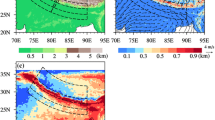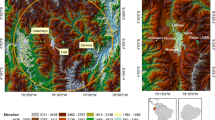Abstract
The precise estimation of precipitation quantities in tropical mountain regions is in great demand by ecological and hydrological studies, due to the heterogeneity of the rainfall distribution and the lack of meteorological station data. This study uses radar images and ground station data to provide the required high-resolution precipitation maps. Also wind data are taken into account, due to its influence on the precipitation formation and to demonstrate the relation between synoptic wind, topography and the precipitation distribution inside small mountain valleys. The study analyses the rainfall distribution and amounts of 4 days inside the San Francisco Valley, a small catchment in the tropical Andes of southern Ecuador, representing different seasons and the typical atmospheric flows, which are correlated to the annual precipitation map. The results show that the rainfall distribution and amounts are generally defined by the wind direction and velocity, besides the topographic location in relation to the main barriers and pathways. The dominant wind direction causes a division of the catchment in a wetter eastern and a dryer western part. Moreover, the annual seasons are reversed; the main rainy season for the eastern part occurs between June and August, while the western part reaches the precipitation maximum between January and March. This may have influence on the species composition at the different slopes and the annual hydrological cycle inside the catchment.









Similar content being viewed by others
References
Barry RG (2008) Mountain weather and climate, 3rd edn. Cambridge University Press, Cambridge
Bendix J, Beck E (2009) Spatial aspects of ecosystem research in a biodiversity hot spot of southern Ecua dor—an introduction. Erdkunde 63(4):305–308
Bendix J, Rollenbeck R, Palacios E (2004) Cloud classification in the tropics—a suitable tool for climate ecological studies in the high mountains of Ecuador. Int J Remote Sens 25(21):4521–4540
Bendix J, Rollenbeck R, Göttlicher D, Cermak J (2006) Cloud occurrence and cloud properties in Ecuador. Clim Res 30:133–147
Bendix J, Rollenbeck R, Richter M, Fabian P, Emck P (2008a) Climate. In: Beck E, Bendix J, Kottke I, Makeschin F, Mosandl R (eds) Gradients in a tropical mountain ecosystem of Ecuador, Ecological studies 198. Springer, Berlin, pp 63–73
Bendix J, Rollenbeck R, Fabian P, Emck P, Richter M, Beck E (2008b) Climate variability. In: Beck E, Bendix J, Kottke I, Makeschin F, Mosandl R (eds) Gradients in a tropical mountain ecosystem of Ecuador, Ecological studies 198. Springer, Berlin, pp 280–291
Bendix J, Rollenbeck R, Göttlicher D, Nauß T, Fabian P (2008c) Seasonality and diurnal pattern of very low clouds in a deeply incised valley of the eastern tropical Andes (South Ecuador) as observed by a cost effective WebCam system. Meteorol Appl 15:281–291
Bendix J, Trachte K, Cermak J, Rollenbeck R, Nauß T (2009) Formation of convective clouds at the foothills of the tropical eastern Andes (South Ecuador). J Appl Meteorol 48:1–17
Breuer L, Windhorst D, Fries A, Wilke W (2013) Supporting, regulation, and provisioning hydrological services. In: Bendix J, Beck E, Bräuning A, Makeschin F, Mosandl R, Scheu S, Wilcke W (eds) Ecosystem services, biodiversity and environmental change in a tropical mountain ecosystem of South Ecuador. Ecological studies 221. Springer, Berlin, pp 107–116
Daly C, Smith JW, Smith JI (2007) High-resolution spatial modelling of daily weather elements for a catchment in the Oregon Cascade Mountains, United States. J Appl Meteorol Climatol 46:1565–1586
Davis BM (1987) Uses and abuses of cross-validation in geostatistics. Math Geol 19(3):241–248
Delrieu G, Boudevillain B, Nicol J, Chapon B, Kirstetter PE, Andrieu H, Faure D (2009) Bolléne-2002 experiment: radar quantitative precipitation estimation in the Cévennes-Vivarais region, France. J Appl Meteorol Climatol 48:1422–1447
Emck P (2007) A climatology of South Ecuador. Dissertation, Friedrich-Alexander Universität Erlangen, Germany
Foresti L, Pozdnoukhov A (2012) Exploration of Alpine orographic precipitation patterns with radar image processing and clustering techniques. Meteorol Appl 19:407–419
Fries A, Rollenbeck R, Göttlicher D, Nauß T, Homeier J, Peters T, Bendix J (2009) Thermal structure of a megadiverse mountain ecosystem in southern Ecuador, and its regionalization. Erdkunde 63(4):321–335
Fries A, Rollenbeck R, Nauß T, Peters T, Bendix J (2012) Near surface air humidity in a megadiverse Andean mountain ecosystem in southern Ecuador and its regionalization. Agric For Met 152:17–30
Gabella M, Notarpietro R, Bertoldo S, Prato A, Lucianaz C, Rorato O, Allegretti M, Perona G (2012) A network of portable, low-cost, XBand radars, Doppler radar observations—weather radar, wind profiler, ionospheric radar, and other advanced applications. In: Bech J (ed) InTech, Croatia, pp 175–202. ISBN: 978-953-51-0496-4
Germann U, Joss J (2004) Operational measurement of precipitation in mountainous terrain. In: Meischner P (ed) Weather radar: principles and advanced applications. Springer, Berlin, pp 52–77
Germann U, Galli G, Boscacci M, Bolliger M (2006) Radar precipitation measurement in a mountainous area. QJR Meteorol Soc 132:1669–1692
Germann U, Berenguer M, Sempere-Torres D, Zappa M (2009) REAL—ensemble radar precipitation estimation for hydrology in a mountainous region. QJR Meteorol Soc 135:445–456
Günter S, Gonzalez P, Alvarez G, Aguirre N, Palomeque X, Haubrich F, Weber M (2009) Determinants for successful reforestation of abandoned pastures in the Andes: soil conditions and vegetation cover. For Ecol Manag 258:81–91
Hijmans RJ, Cameron SE, Parra JL, Jones PG, Jarvis A (2005) Very high resolution interpolated climate surfaces for global land areas. Int J Climatol 25:1965–1978
Houze RA Jr, James CN, Medina S (2001) Radar observations of precipitation and airflow on the Mediterranean side of the Alps: autumn 1998 and 1999. QJR Meteorol Soc 127:2537–2558
Hutchinson MF (1998a) Interpolation of rainfall data with thin plate smoothing splines: I. Two dimensional smoothing of data with short range correlation. J Geogr Inf Decis Anal 2:139–151
Hutchinson MF (1998b) Interpolation of rainfall data with thin plate smoothing splines: II. Analysis of topographic dependence. J Geogr Inf Decis Anal 2:168–185
INAMHI (Instituto Nacional de Hidrología y Meteorología) (2000–2009) Anuarios Meteorológicos. Quito, Ecuador. http://www.serviciometeorologico.gob.ec/biblioteca/. Accessed 31 Jan 2014
Jensen NE (2002) X-band local area weather radar—preliminary calibration results. Water Sci Technol 45:135–138
Jensen NE (2004) Local area weather radar documentation. DHI-Institute for the water environment: DHI/LAWR/TN 2/10-2004 V 3.0
Jiménez PA, González-Rouco JF, Montávez JP, Navarro J, García-Bustamante E, Valero F (2008) Surface wind regionalization in complex terrain. J Appl Meteorol Climatol 47:308–325
Johansson B, Chen D (2005) Estimation of areal precipitation for runoff modelling using wind data: a case study in Sweden. Clim Res 29:53–61
Ludwig FL, Horel J, Whiteman CD (2004) Using EOF analysis to identify important wind pattern in mountain valley. J Appl Meteorol 43:969–983
Luo W, Taylor MC, Parker SR (2008) A comparison of spatial interpolation methods to estimate continuous wind speed surfaces using irregularly distributed data from England and Wales. Int J Climatol 28:947–959
McVicar TR, Van Niel TG, Roderick ML, Li LT, Mo XG, Zimmermann NE, Schmatz DR (2010) Observational evidence from two mountain regions that near-surface winds speeds are declining more rapidly at higher elevation than lower elevations: 1960–2006. Geophys Res Lett 37. doi:10.1029/2009gl042255
Neiman PJ, White AB, Ralph FM, Gottas DJ, Gutman SI (2009) A water vapour flux tool for precipitation forecasting. Water Manag 162:83–94
New M, Hulme M, Jones P (2000) Representing twentieth-century space–time climate variability. Part II: development of 1901–96 monthly grids of terrestrial surface climate. J Climate 13:2217–2238
Ochoa P, Fries A, Pilar M, Rodríguez-Díaz JA, Boll J (2013) Spatial estimation of soil erosion risk by land-cover change in the Andes of southern Ecuador. Land Degrad Dev. doi:10.1002/ldr.2219
Oñate-Valdivieso F, Bosque Sendra J (2007) Extracción de modelos digitales de elevación a partir de imágenes ASTER para la determinación de características morfométricas de cuencas hidrográficas (in Spanish). In: Rivas R, Grisotto A, Sacido M (eds) Teledetección: Hacia un mejor entendimiento de la dinámica global y regional. XII Congreso de la Asociación Española de Teledetección, Mar del Plata, pp 457–464
Palomino I, Martín F (1995) A simple method for spatial interpolation of wind in complex terrain. J Appl Meteorol 34:1678–1693
Panziera L, Germann U (2010) The relation between airflow and orographic precipitation on the southern side of the Alps as revealed by weather radar. QJR Meteorol Soc 136:222–238
Poveda G, Mesa OJ, Salazar LF, Arias PA, Moreno HA, Vieira SC, Agudelo PA, Toro VG, Alvarez JF (2005) The diurnal cycle of precipitation in the tropical Andes of Columbia. Mon Weather Rev 133:228–240
Richter M (2003) Using plant functional types and soil temperatures for eco-climatic interpretation in southern Ecuador. Erdkunde 57:161–181
Richter M, Moreira-Muñoz A (2005) Heterogeneidad climática y diversidad vegetacional en el sur de Ecuador: un método de fitoindicación (in Spanish). Revista Peruana de Biología 12:217–238
Rollenbeck R, Bendix J (2006) Experimental calibration of a cost-effective X-band weather radar for climate ecological studies in southern Ecuador. Atmos Res 79:296–316
Rollenbeck R, Bendix J (2011) Rainfall distribution in the Andes of southern Ecuador derived from blending weather radar data and meteorological field observations. Atmos Res 99:277–289
Rollenbeck R, Bendix J, Fabian P, Boy J, Dalitz H, Emck P, Oesker M, Wilcke W (2007) Comparison of different techniques for the measurement of precipitation in tropical montane rain forest regions. J Atmos Ocean Technol 24:156–168
Rollenbeck R, Bendix J, Fabian P (2011) Spatial and temporal dynamics of atmospheric water inputs in tropical mountain forests of South Ecuador. Special issue: hydrometeorology of tropical montane cloud forests. Hydrol Process 25(3):344–352
Rotunno R, Houze RA (2007) Lessons on orographic precipitation from the Mesoscale Alpine Programme. QJR Meteorol Soc 133:811–830
Smith RB (2003) A linear upslope-time-delay model for orographic precipitation. J Hydrol 282:2–9
Szturc J, Katarzyna O, Jurczyk A (2011) Quality index scheme for quantitative uncertainty characterization of radar-based precipitation. Meteorol Appl 18:407–420
Tait A, Henderson R, Turner R, Zheng X (2006) Thin plate smoothing spline interpolation of daily rainfall for New Zealand using a climatological rainfall surface. Int J Climatol 26:2097–2115
Tomczak M (1998) Spatial interpolation and its uncertainty using automated anisotropic inverse distance weighting (IDW)—cross-validation/Jackknife approach. J Geogr Inf Decis Anal 2(2):18–30
Trachte K, Nauß T, Bendix J (2010) The impact of different terrain configurations on the formation and dynamics of katabatic flows—idealized case study. Bound-Layer Meteorol 134(2):307–325
Villarini G, Krajewski WF (2010) Review of the different sources of uncertainty in single polarization radar-based estimates of rainfall. Survey Geophys 31:107–129
Vuille M, Raymond S, Keimig B, Keimig F (2000) Interannual climate variability in the Central Andes and its relation to tropical Pacific and Atlantic forcing. J Geophys Res 105:12447–12460
Wang Y, Chandrasekar V (2010) Quantitative precipitation estimation in the CASA X-band dual polarization radar network. J Atmos Ocean Technol 27:1665–1676
White AB, Neiman PJ, Ralph FM, Kingsmill DE, Persson POG (2003) Coastal orographic rainfall processes observed by radar during the California land-falling jets experiment. J Hydrometeorol 4:264–282
Windhorst D, Waltz T, Timbe E, Frede HG, Breuer L (2013) Impact of elevation and weather patterns on the isotopic composition of precipitation in a tropical montane rainforest. Hydrol Earth Syst Sci 17:409–419
Acknowledgments
The current study was conducted within the framework of the DFG Research Group FOR 816 “Biodiversity and sustainable management of a megadiverse mountain rain forest in South Ecuador” and was generously funded by the German Research Council (DFG, BE 1780/15-2). The methodical knowledge of radar calibration is fundamental for the building of the radar network (RNSE), which is a cooperation project between DFG and the Provincial Government of Loja (GPL; BE 1780/31-1). Special thanks go to the Foundation “Naturaleza y Cultura Internacional” (NCI, Loja) for logistic support, the Universidad Técnica Particular de Loja (UTPL) for the support of the research activities, and the Ministry of the Environment of Ecuador (MAE) for the permission of the research.
Author information
Authors and Affiliations
Corresponding author
Additional information
Responsible editor: C. Simmer.
Rights and permissions
About this article
Cite this article
Fries, A., Rollenbeck, R., Bayer, F. et al. Catchment precipitation processes in the San Francisco valley in southern Ecuador: combined approach using high-resolution radar images and in situ observations. Meteorol Atmos Phys 126, 13–29 (2014). https://doi.org/10.1007/s00703-014-0335-3
Received:
Accepted:
Published:
Issue Date:
DOI: https://doi.org/10.1007/s00703-014-0335-3




